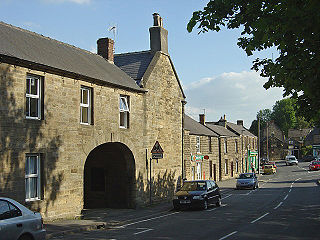
Ripley is a market town and civil parish in the Amber Valley district of Derbyshire, England, northeast of Derby, northwest of Heanor, southwest of Alfreton and northeast of Belper. The town is continuous with Heanor, Eastwood and Ilkeston as part of the wider Nottingham Urban Area.

Alfreton is a town and civil parish in the Amber Valley district of Derbyshire, England. The town was formerly a Norman Manor and later an Urban District. The population of the Alfreton parish was 8,799 at the 2021 Census. The villages of Ironville, Riddings, Somercotes and Swanwick were historically part of the Manor and Urban District, and the population including these was 24,476 in 2001.

William Jessop was an English civil engineer, best known for his work on canals, harbours and early railways in the late 18th and early 19th centuries.

The Cromford Canal ran 14.5 miles from Cromford to the Erewash Canal in Derbyshire, England with a branch to Pinxton. Built by William Jessop with the assistance of Benjamin Outram, its alignment included four tunnels and 14 locks.

Derbyshire Constabulary is the territorial police force responsible for policing the county of Derbyshire, England. The force covers an area of over 1,000 square miles (3,000 km2) with a population of just under one million.

Crich is a village and civil parish in the English county of Derbyshire. Besides the village of Crich, the civil parish includes the nearby villages of Fritchley, Whatstandwell and Wheatcroft. The population of the civil parish at the 2001 census was 2,821, increasing to 2,898 at the 2011 census.
Benjamin Outram was an English civil engineer, surveyor and industrialist. He was a pioneer in the building of canals and tramways.

The Little Eaton Gangway, officially the Derby Canal Railway, was a narrow gauge industrial wagonway serving the Derby Canal, in England, at Little Eaton in Derbyshire.

Ironville in Derbyshire, England, was built about 1830 by the Butterley Company as a model village to house its workers. The population of the civil parish was 1,930 at the 2021 Census. It is situated between Riddings and Codnor Park.

Butterley is a village in the civil parish of Ripley, in the Amber Valley district, in the county of Derbyshire, England. The area is dominated by the now disused site of the Butterley Company and the Butterley Reservoir. It is the headquarters of the Midland Railway – Butterley, located at the site of the Butterley Railway Station.
Josias Jessop (1781–1826) was a canal engineer, and second son of William Jessop, one of the great canal engineers of the late eighteenth and early nineteenth centuries. He was trained by his father, and worked under him on his early projects, but proved his abilities during the construction of Bristol harbour. He became an independent consulting engineer from 1811. He died fourteen years later, a little before he reached the age of 45.

Lieutenant-General Sir James Outram, 1st Baronet was a British general who fought in the Indian Rebellion of 1857.

The Butterley Company was an English manufacturing firm founded as Benjamin Outram and Company in 1790. Its subsidiaries existed until 2009.

Bullbridge is a small village in Derbyshire. The Bull bridge accident, in which a railway bridge failed as a goods train was just passing over it, happened here in 1860.

Butterley Tunnel is a 3,083-yard (2,819 m) disused canal tunnel on the Cromford Canal below Ripley, in Derbyshire, England, opened to traffic in 1794. Along with Butterley Works blast furnaces, part of the canal tunnel and its underground wharf were declared a scheduled monument in 2013.

Fritchley is a small village in Derbyshire, England, situated to the south of Crich and north of Ambergate. It falls under the civil parish of Crich. To the east of the village is the ruin of a windmill. Fritchley has an active Congregational Church, and there is a Quaker meeting house with an active Quaker Meeting. There is a pub, the Red Lion, but the post office closed in 2009. The village hosts a steam rally each August.

Parwich Hall is a privately owned 18th-century mansion house at Parwich, near Ashbourne, Derbyshire Dales. It is a Grade II* listed building.

Langar Hall is a Grade II listed house, now a hotel, next to the church in Langar, Nottinghamshire.
Fritchley Tunnel is a disused railway tunnel at Fritchley in Derbyshire, England, which is believed to be the oldest surviving example in the world. The tunnel was constructed in 1793 by Benjamin Outram as part of the Butterley Gangroad, altered in the 1840s, and remained in use until the railway closed in 1933. It is a scheduled monument.

Francis Wright JP DL, was a British industrialist and philanthropist.

















